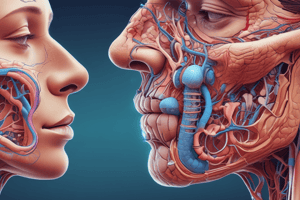Podcast
Questions and Answers
What is the overall function of the respiratory system?
What is the overall function of the respiratory system?
The overall function of the respiratory system is gas exchange between the organism and the external environment, specifically the exchange of CO2 and O2.
What are the anatomical divisions of the respiratory system?
What are the anatomical divisions of the respiratory system?
The anatomical divisions of the respiratory system are the upper respiratory tract (nose, pharynx, and associated structures) and the lower respiratory tract (larynx, trachea, bronchi, and lungs).
What is the functional classification of the respiratory system?
What is the functional classification of the respiratory system?
The functional classification of the respiratory system includes the conductive portion (filtering, humidifying, and moistening the air) and the respiratory portion (site of gas exchange).
What are the major types of cells in respiratory epithelium?
What are the major types of cells in respiratory epithelium?
What is the function of the lamina propria in the nasal cavity?
What is the function of the lamina propria in the nasal cavity?
What are the components of the trachea?
What are the components of the trachea?
What is the main difference between bronchi and bronchioles?
What is the main difference between bronchi and bronchioles?
What are the characteristics of club cells?
What are the characteristics of club cells?
What are the differences between terminal bronchioles and respiratory bronchioles?
What are the differences between terminal bronchioles and respiratory bronchioles?
What is the structure of alveolar sacs?
What is the structure of alveolar sacs?
What are the functions of type I alveolar cells?
What are the functions of type I alveolar cells?
Flashcards are hidden until you start studying
Study Notes
Overview of the Respiratory System
- The respiratory system's overall function is to facilitate the exchange of oxygen and carbon dioxide between the atmosphere and the body's cells.
Anatomical Divisions of the Respiratory System
- The respiratory system can be divided into the upper respiratory tract (nose, nasal cavity, and pharynx) and the lower respiratory tract (larynx, trachea, bronchi, and lungs).
Functional Classification of the Respiratory System
- The respiratory system can be functionally classified into the conducting zone (passageways that transport air), the respiratory zone (where gas exchange occurs), and the transitional zone (bronchioles that connect the conducting and respiratory zones).
Respiratory Epithelium
- The respiratory epithelium is composed of ciliated pseudostratified columnar epithelial cells, basal cells, and mucous cells.
- Club cells, also known as Clara cells, are non-ciliated, columnar cells that produce surfactant and have a role in detoxification.
Nasal Cavity
- The lamina propria in the nasal cavity is a layer of loose connective tissue that supports the respiratory epithelium and contains mucous glands and blood vessels.
Trachea
- The trachea is composed of C-shaped cartilaginous rings, fibroelastic connective tissue, and a mucous membrane lining.
Bronchi and Bronchioles
- Bronchi are larger, more proximal airways that branch into smaller bronchioles, which eventually terminate in alveolar sacs.
- The main difference between bronchi and bronchioles is their size and location, with bronchi being larger and more proximal to the trachea.
Alveolar Sacs and Alveolar Cells
- Alveolar sacs are clusters of alveoli, where gas exchange occurs.
- Type I alveolar cells are flat, squamous cells that form the majority of the alveolar surface and facilitate gas exchange.
- Terminal bronchioles branch into respiratory bronchioles, which then lead to alveolar ducts and eventually alveolar sacs.
- Respiratory bronchioles are smaller and more distal than terminal bronchioles.
Studying That Suits You
Use AI to generate personalized quizzes and flashcards to suit your learning preferences.



